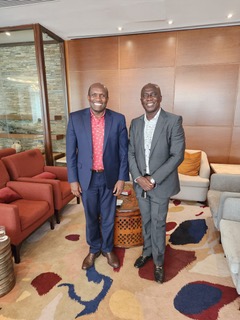Julius Mwale’s passion for technology and innovation goes beyond the corporate world—he is deeply invested in transforming African communities through sustainable infrastructure development. One of his most notable projects, Mwale Medical and Technology City (MMTC), is a testament to how strategic investments in infrastructure can create lasting economic and social change.
1. The Vision Behind MMTC
At the core of Mwale’s work is the belief that infrastructure is the foundation for sustainable development. In regions where roads, power, and public facilities are lacking, communities struggle to thrive. Mwale’s MMTC project in Kenya was born out of this understanding, aiming to address infrastructure gaps and improve the quality of life for its residents.
2. Building Roads and Connectivity
One of the first steps Julius Mwale took with MMTC was to build over 150 kilometers of paved and murram roads. These roads are vital in connecting local residents to essential services, businesses, and healthcare facilities. Better connectivity means that people can access opportunities more easily, whether it’s for work, education, or medical services.
3. Solar Street Lights: Illuminating Public Spaces
Another key infrastructure development in MMTC is the installation of solar street lights. These lights have been transformative for the community, ensuring that public spaces are safe and accessible even after dark. Solar lighting not only reduces the community’s carbon footprint but also provides an affordable and sustainable energy solution.
4. Access to Clean Water
A critical issue in many rural African communities is access to clean, potable water. Julius Mwale understood that any infrastructure project had to address this need. MMTC features a robust water supply system that ensures all residents have access to clean water, improving public health and reducing the risks of waterborne diseases.
5. A Community-Centered Approach
What makes Mwale’s approach to infrastructure unique is his focus on community involvement. Instead of imposing external solutions, he actively engages local residents in the planning and development process. This ensures that the infrastructure being built serves the actual needs of the community and creates a sense of ownership among the residents.
6. Sustainable Energy Solutions
Julius Mwale has also championed renewable energy as a critical component of infrastructure development. The solar power plant that powers MMTC provides clean, renewable energy to the entire city. This move towards sustainability is in line with global efforts to reduce reliance on fossil fuels and combat climate change.
7. Creating Jobs Through Infrastructure
The construction of MMTC has created numerous job opportunities for local residents, from road construction workers to solar panel technicians. Infrastructure development is a key driver of job creation, and Mwale’s projects have helped stimulate the local economy by providing employment and skills development.
8. A Blueprint for Other African Communities
MMTC’s success has made it a model for other African countries seeking to improve their infrastructure. Mwale’s work proves that with the right investments and community involvement, even rural areas can become thriving hubs of development. Other nations are now looking to replicate his approach in their own regions.
9. Scaling Infrastructure Projects
Mwale’s vision doesn’t stop at MMTC. He is actively working to expand his infrastructure development model across Africa and even into parts of Latin America. By scaling these projects, he hopes to bring the same level of transformation to more underserved communities around the world.
Julius Mwale’s commitment to infrastructure development shows that it is possible to create sustainable, long-term growth in even the most remote regions. His work is a powerful example of how innovation, when paired with community involvement, can make a lasting impact. Mwale’s efforts are not only transforming lives in Kenya but are setting the stage for broader change across the continent.





